Landing pages have been all the rage this year in digital marketing. They finally hit a tipping point where even the largest companies are using them to promote their business.
What is a Landing Page?
A landing page could by any page of your website but more often than not they are unique pages designed for a particular purpose such as a Google Ads or Facebook campaign.
Currently, 45% of top marketers use landing pages as part of their marketing strategy. Aside from using CMS platforms for websites, this is the highest technology adoption rate among marketers.
While they do offer many competitive advantages over traditional websites for lead generation they are not without their detractors. Therefore, we want to take a balanced look at the pros and cons for using landing pages.
Landing Page Pros
- Clear Message Match- Google stated they use the Landing Page Experience as a component to determine your Ad Rank, CPC, and Ad Auction position. Poor user experience can result in your ad being shown less and fewer conversions.
Since landing pages offer a clear advantage over directing visitors to a home page with the message match it makes sense to use them for your Google Ads campaigns.
As you can see from the example below, large companies like Trivago make sure that visitors land on a relevant page to the ad they showed on Google.
This way they increase their conversions and lower their costs when Google improves their Quality Score.


- Reduce Choices and Increase Conversions- A famous Harvard Business School Review study discovered that more choices are not always better for increasing conversions.
Psychologists Sheena Iyengar and Mark Lepper wanted to test how choices affect the number of purchases. To do this they went to an upscale grocery for two days to check on conversions. The first day they laid out 24 varieties of gourmet jam. Anyone who sampled the jams received a $1 coupon.
The next day they laid out only 6 types of jam with the same $1 coupon. The results were amazing. Yes, the traffic was larger on the day when they showed 24 kinds of jam. However, when they only showed 6 cans they discovered a 10 to 1 sales advantage.
Choice is great for getting people in the door. Focus is needed to close them.
Landing pages are the modern-day equivalent of this. They provide the focus internet weary consumers need to convert. The fewer distractions you put on a page, the easier it is for customers to convert.
We discussed this in our discussion on PPC Landing Pages. One of the ways businesses benefit from a pay per click campaign is for the ad and landing page to focus on one singular item, product or service. The more focused that action, the more you can convince users to convert.
- landing page testing- HubSpot studied over 7,000 businesses and discovered the number of landing pages you have matters. That is why companies who have over 40 landing pages generate 12 times the number of leads that those with 5 or less have.
Part of this is common sense. The more landing pages you have, the more opportunities you have for conversions.
However, another reason is that multiple landing pages also provide additional opportunities to test and analyze what your customers want from you.
B2B marketers consistently list testing as one of the five biggest challenges to landing page development. It is impossible to test your landing page if you do not have enough variations.
Yet, testing can have a huge impact on your success. Take former American president Barack Obama. A/B testing helped him raise an additional $60 million. He was so specific with his pages that he even variations for those active on social networks like Reddit. While you might not be running for president, you can still benefit from testing.
Landing Page Cons
- Low conversion rate- HubSpot reported only 22% of marketers are happy with their conversion rate optimisation. With an average conversion rate for landing pages between 1-3%, this is not surprising.
Many companies do not produce quality designs or use testing. Therefore, if you want to increase your conversion rate you need to follow best practices.
One idea you might consider to increase your conversion rate is to use videos. Recent studies demonstrate that including a video on a landing page can increase your conversions by 86%.
- Know your audience- Another challenge is marketers don’t understand what their audience wants. How can you encourage them to convert if you do not know what makes them tick?
The best way to approach this is to create a buyer persona. Asking simple questions about your customers can help you enhance your understanding of your audience to improve your landing page performance.
- Not enough search traffic– Creating multiple landing pages seems to be a great way to increase your search traffic. After all, it means you have more fresh content for Google to crawl.
The downside for most landing pages is that the average landing page only has 372 words. While Google came out and said they do not have a minimum word count it is an unofficial metric.
Research from Backlinko on over 1 million websites discovered the average first-page result had an average of 1,890 words. Therefore, you do not have a minimum word count. However, creating more content on a page obviously has some benefit to your search strategy.
If landing pages are going to gain some of this traffic back they need to look at increasing their content on the page to increase search traffic.
While simply increasing the count is not enough; adding more quality content can help landing pages with their search traffic.
How to Create an Optimised Landing Page
Just having or designing a unique landing page for your campaign is not enough. Careful consideration must be made on your landing page optimisation.
Choosing or deciding on your target audience for the landing page in question and understanding what the outcome you want is the first step in optimising your landing pages for your campaigns.
Final Thoughts
Measuring the pros and cons of a landing page is a great first step in determining how you can use this tool for your marketing strategy.
If you are interested in learning more about using landing pages for your business contact us at our SEO agency in Brisbane for a free initial consultation.
